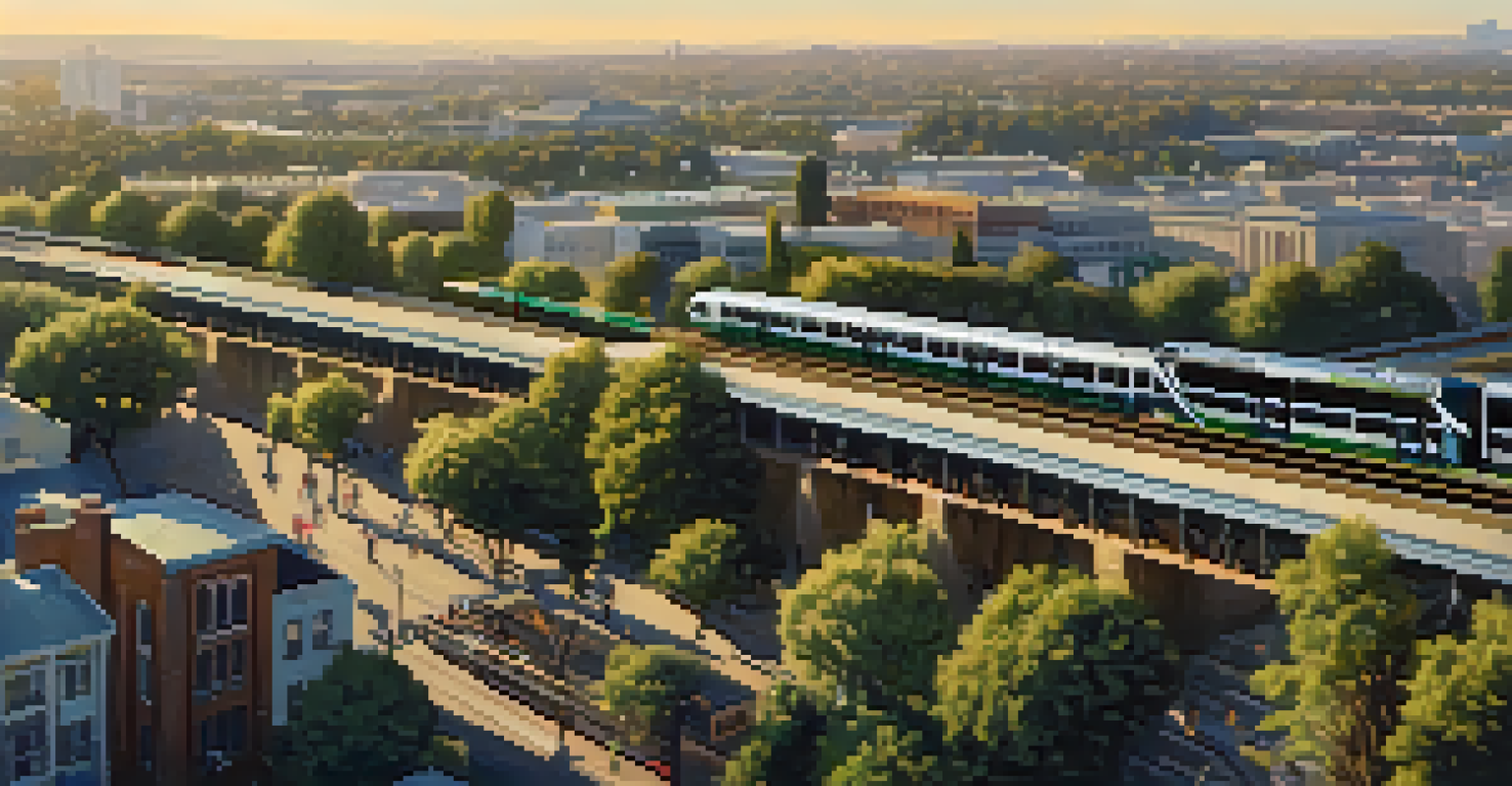Public Transit Improvements: A Key to Sacramento's Growth

Understanding Sacramento's Current Transit Landscape
Sacramento's public transit system has undergone significant changes in recent years. With its mix of buses, light rail, and commuter services, the system serves a diverse population. However, many residents still face challenges, such as limited routes and infrequent service. Understanding these issues is the first step toward identifying effective improvements.
Public transport is not just a means of getting from one place to another; it's a lifeline that connects people to jobs, education, and their communities.
As the city grows, the demand for reliable and efficient transit options becomes more pressing. An increasing population means more cars on the road, leading to congestion and longer commute times. This scenario isn't just inconvenient; it impacts air quality and overall quality of life in the region. Hence, transforming public transit is not merely an option; it's a necessity.
Improving public transit can directly affect the community's accessibility and connectivity. Enhanced transit options can connect residents to jobs, education, and essential services, making life easier for everyone. By addressing current shortcomings, Sacramento can pave the way for a brighter, more sustainable future.
The Role of Public Transit in Economic Growth
Public transit is more than just a way to get from point A to point B; it’s a catalyst for economic development. By improving transit access, Sacramento can attract new businesses and encourage existing ones to expand. This growth not only creates jobs but also enhances local revenues through increased consumer spending.

Consider how major cities have thrived by investing in their transit systems. For example, cities like Portland and San Francisco have seen substantial economic boosts linked to their transit expansions. As Sacramento aims to compete with these urban powerhouses, revitalizing its transit network could be the key to unlocking similar potential.
Transit Enhancements Drive Growth
Improving public transit access can stimulate economic development by attracting new businesses and increasing job opportunities.
Moreover, a robust public transit system can increase property values in surrounding neighborhoods. When people know they have easy access to transit, they are more likely to invest in homes and businesses nearby. This creates a virtuous cycle of growth, where improved transit leads to economic benefits that can further fund enhancements.
Environmental Benefits of Enhanced Transit Options
Investing in public transit isn’t just about convenience; it’s also crucial for the environment. Improved transit systems can significantly reduce the number of cars on the road, leading to lower greenhouse gas emissions. With climate change being a pressing issue, every bit of reduction helps in the fight for a healthier planet.
Investing in public transit is investing in the future of our cities, ensuring that we can grow sustainably while reducing our carbon footprint.
By providing reliable public transportation, the city can encourage residents to opt for transit over personal vehicles. This shift not only lessens traffic congestion but also promotes cleaner air. Reducing reliance on cars can significantly decrease local pollution levels, making Sacramento a more attractive place to live.
Moreover, enhancing public transit can lead to increased use of pedestrian and cycling infrastructure. As people become more engaged with transit options, they are likely to embrace alternative forms of transportation. This holistic approach to transit improvement can create a more sustainable urban environment overall.
Community Engagement in Transit Planning
Community engagement is vital when planning public transit improvements. Involving residents in the conversation ensures that the services meet their needs and preferences. Public forums, surveys, and workshops can provide valuable insights into what the community wants from its transit system.
When residents feel heard, they are more likely to support and utilize transit options. This buy-in is crucial for the success of any transit initiative. By fostering a sense of ownership, the community can help shape a transit system that reflects its unique culture and values.
Environmental Impact of Transit
Investing in public transit reduces car dependency, lowering greenhouse gas emissions and promoting cleaner air in Sacramento.
Moreover, engaging with diverse community groups helps address equity issues within transit planning. Ensuring that all voices are heard—especially those from marginalized communities—leads to a more inclusive transit system. This commitment to equity can strengthen community ties and create a sense of belonging among residents.
Funding Strategies for Transit Improvements
Securing funding is a critical aspect of transit improvements in Sacramento. Various funding sources can be explored, including federal grants, state funding, and local tax measures. By diversifying funding strategies, the city can reduce the burden on taxpayers while still pushing forward with necessary improvements.
Public-private partnerships can also play a significant role in funding transit projects. Collaborating with private entities can lead to innovative solutions and shared investment in infrastructure. This approach not only brings in capital but also encourages businesses to take an active interest in the community's development.
Additionally, leveraging technology and smart transit solutions can attract new funding opportunities. Many grant programs prioritize projects that incorporate sustainable technology. Emphasizing innovation can create a compelling case for funding that can transform Sacramento’s transit landscape.
Technology's Impact on Public Transit Efficiency
Technology is revolutionizing public transit, making systems more efficient and user-friendly. Real-time tracking apps, for instance, allow riders to plan their journeys more effectively. By integrating technology into transit services, Sacramento can enhance the overall user experience and encourage more people to use public transportation.
Moreover, smart ticketing systems simplify the payment process. With options like mobile ticketing, riders can easily purchase and store their passes on their phones. Streamlining the fare collection process not only improves convenience but also can increase ridership as barriers to entry are reduced.
Community Involvement is Key
Engaging residents in transit planning ensures that services meet their needs and fosters a sense of ownership and support.
Furthermore, data analytics can help transit authorities understand ridership patterns and optimize routes accordingly. By analyzing where and when people travel, Sacramento can make informed decisions about service adjustments. This data-driven approach ensures that the transit system aligns with the community's evolving needs.
Future Vision: A Transit-Driven Sacramento
Envisioning a transit-driven Sacramento means looking ahead to what could be possible with sustained investment and innovation. A well-connected public transit system can enhance the quality of life for residents while supporting the city’s growth goals. Imagine a future where commuting is seamless, and everyone has easy access to education, employment, and leisure activities.
This vision also includes a commitment to sustainability. By prioritizing environmentally friendly transit options, Sacramento can serve as a model for other cities. The goal is to create a city that values not just growth, but smart, responsible growth that respects both its residents and the planet.

Ultimately, the journey toward this vision requires collaboration, funding, and community engagement. As Sacramento embraces public transit improvements, it can set the stage for a thriving, accessible, and sustainable future. With everyone on board, the possibilities are limitless.